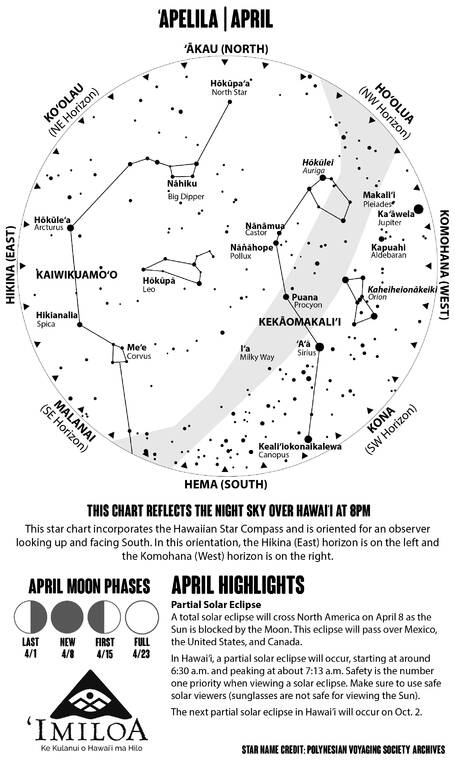Skywatch: Astronomy news and happenings
Featured Maunakea observatory discovery/ observation/news
Astronomers using archival data from the Gemini Observatory on Maunakea have measured the heaviest pair of supermassive black holes ever found.
ADVERTISING
Located within an elliptical galaxy, this binary has a mass measured at 28 billion times that of our Sun and is the only such pair to have been resolved in enough detail to see both objects separately. With a separation of 24 light years between them, the supermassive black holes also hold the record for having the smallest separation ever directly measured. But will they ever collide?
While gravitational waves from mergers of stellar-mass black holes have been detected, according to Gemini, the question of whether supermassive black holes, formed from the merger of galaxies, will eventually collide has been discussed for decades. What the astronomers found by measuring this gigantic pair, stuck in a cosmic dance with each other at the same distance for more than 3 billion years, is that an eventual collision in this system appears unlikely.
When galaxies merge, supermassive black holes slingshot past each other as they settle into an orbit. Energy is then transferred to the surrounding stars with each pass they make, causing them to be dragged closer.
However, the astronomers believe the merger may have stalled because the black holes have nearly cleared their vicinity of stars and gas. If a merger does occur, the resulting gravitational waves would be a hundred million times more powerful than those produced by stellar-mass black hole mergers.
Read more at: https://www.gemini.edu/pr/astronomers-measure-heaviest-black-hole-pair-ever-found.
Special events
Partial Solar Eclipse: A total solar eclipse will cross North America on April 8 as the Sun is blocked by the Moon. This eclipse will pass over Mexico, the United States, and Canada. In Hawai‘i, a partial solar eclipse will occur, starting at around 6:30 a.m. and peaking at about 7:13 a.m.
Safety is the number one priority when viewing a solar eclipse. Make sure to use safe solar viewers (sunglasses are not safe for viewing the Sun). For safety tips, visit https://science.nasa.gov/eclipses/safety/.
The next partial solar eclipse in Hawai‘i will occur on Oct. 2.
Meteor Shower: The Lyrids meteor shower will peak in Hawai‘i on April 21-22, with up to 18 meteors per hour visible. The Lyrids is named after the constellation Lyra. The shooting stars are created from the debris of the comet Thatcher. The Lyrids meteor shower is the oldest known shower ever recorded, as chronicled in the Zuo Zhuan in 687 B.C.
Evening observing
During the early evening hours of April, stargazers will be able to observe two of the four navigational starlines at the same time — Kekaomakali‘i and Kaiwikuamo‘o.
Kekaomakali‘i, the bailer of Makali‘i, stretches overhead in the Western sky. The great celestial bailer starts in the north with the hexagonal shape of Hokulei, a lei of stars, passes in a gentle arc through the stars Nanamua and Nanahope, then to Puana and the brightest star in the evening sky, ‘A‘a, before dropping down to to Keali‘iokonaikalewa to form the handle of the bailer.
A bailer is used to scoop out water that might be flooding a canoe; however, Kekaomakali‘i is not a bailer for water, but a bailer for the stars. Over the course of the night, the celestial bailer will scoop up the stars from the horizon in the East and scatter them overhead and carry them to the West. The bailer will be scattering the shape of Kaheiheionakeiki, which is also known as Orion the hunter, and the famous star cluster of Makali‘i, into the Komohana (West) horizon in the early evening.
The next navigational star family – Kaiwikuamo‘o, the backbone – will be seen toward the Hikina (East). Kaiwikuamo‘o is significant as it stretches all the way from North to South.
Starting at Hokupa‘a, the North Star, through Nahiku, the Big Dipper, Kaiwikuamo‘o then follows the arc of Nahiku to Hokule‘a and to Hikianalia, then passing through Me‘e, where it will then drop straight down to Hanaiakamalama, the Southern Cross.
April will be the last month that we will still be able to view the star cluster of Makali‘i in the early evening sky until November when the season of Makahiki will begin again. The notable cluster will be close to the northwestern horizon in the early evening.
The star cluster of Makali‘i, also known as the Pleiades, is an open cluster that contains thousands of stars. This open cluster was born from a star forming nebula approximately 100 million years ago, as all of the stars are about the same age astronomers will use open clusters like Makali‘i to study how different types of stars live out their lifetimes.
Morning observing
Throughout April, sunrise will occur between 6 a.m. and 6:30 a.m. During these early morning hours, the planets Saturn (Makulu) and Mars (Hoku‘ula) will be rising from the Hikina (East) horizon. Through a very good pair of binoculars or a telescope, early morning observers can spot the famous rings of Saturn.
In the Hema (Southern) part of the sky, observers will also find the celestial shape of Kamakaunuiamaui, Maui’s Fishhook. When we look at the bulge of the Milky Way, sitting behind Maui’s Fishhook, we are looking towards the central regions of our home galaxy.
Sky Watch is a monthly column provided by ‘Imiloa Astronomy Center.


